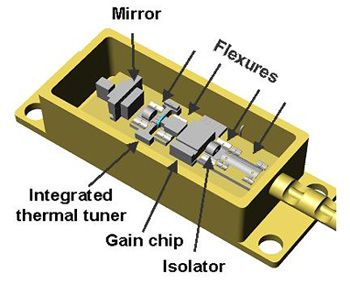Wednesday, March 30, 2005
New Intel laser tech could bring
Photonics to the Masses
By Wolfgang Gruener

Santa Clara (CA) - Optical components that provide high-bandwidth data transmission today are mostly used in the telecommunications industry and are often too expensive for mainstream technologies. Intel now claims to have found a way to use silicon as optical material - a discovery that could lead to cheaper lasers as well as faster and more capable networks.
Intel calls its "breakthrough" research the "first continuous silicon laser" which allows amplifying photons within silicon material to create a laser output beam. Silicon so far was considered to be unsuited for such an application due to its nature to create strong electromagnetic interference and absorb most of the source light.
The laser announced is based on the so-called Raman effect, published by Venkata Raman back in 1928 and a first laser that was built on this theory in 1962. The effect is based on the discovery that light is pumped into a material and amplified by oscillating photons between two mirrors thus creating a intense light source and allow a laser beam to exit on side. This effect is about 10,000 times stronger in silicon than in glass fiber which allows amplification to be created in centimeter rather than kilometer distances, according to Intel.

READ MORE:http://www.lightreading.com/document.asp?doc_id=26966
http://www.tomshardware.com/hardnews/20050216_145922.html
http://www.intel.com/pressroom/archive/releases/20040224net.htm
|
Photonics to the Masses
By Wolfgang Gruener

Santa Clara (CA) - Optical components that provide high-bandwidth data transmission today are mostly used in the telecommunications industry and are often too expensive for mainstream technologies. Intel now claims to have found a way to use silicon as optical material - a discovery that could lead to cheaper lasers as well as faster and more capable networks.
Intel calls its "breakthrough" research the "first continuous silicon laser" which allows amplifying photons within silicon material to create a laser output beam. Silicon so far was considered to be unsuited for such an application due to its nature to create strong electromagnetic interference and absorb most of the source light.
The laser announced is based on the so-called Raman effect, published by Venkata Raman back in 1928 and a first laser that was built on this theory in 1962. The effect is based on the discovery that light is pumped into a material and amplified by oscillating photons between two mirrors thus creating a intense light source and allow a laser beam to exit on side. This effect is about 10,000 times stronger in silicon than in glass fiber which allows amplification to be created in centimeter rather than kilometer distances, according to Intel.

READ MORE:
http://www.tomshardware.com/hardnews/20050216_145922.html
http://www.intel.com/pressroom/archive/releases/20040224net.htm
|

